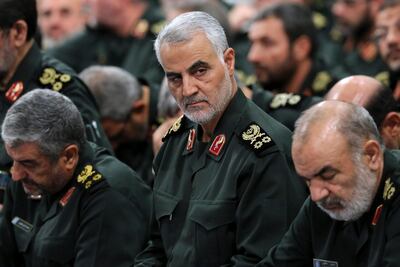A rare interview conducted earlier this week with Qassem Suleimani, the highly-influential Iranian commander of the Revolutionary Guard’s Quds Force, has provided a fascinating insight into how his organisation manages relations between Tehran and its numerous proxies throughout the Middle East.
For outsiders, one of the perennial challenges they face is trying to work out who controls the levers of power in the Islamic Republic.
On one level there is the democratically elected government, which is currently headed by President Hassan Rouhani, who is answerable to the country’s majlis, or parliament, whose members are also elected at the ballot box.
On another there is the unique position of the country's supreme leader who, under Iran's unique concept of the Vilayat-e Faqih, derives his authority from Islam, and is therefore considered to have authority over the country's democratically-elected bodies.
Consequently, these two major factions in Iran, the spiritual and the democratic, often finds themselves at loggerheads on major policy issues, especially when it comes to prosecuting Iran’s overseas military adventures.
While senior members of the Iranian government, such as Mr Rouhani and Javad Zarif, Iran’s ubiquitous foreign minister, like to give the impression to the international community that they are ultimately responsible for representing their government’s interests, the reality is, as Mr Suleimani’s interview makes abundantly clear, very different.
In the 90-minute interview, which was broadcast on Iranian state television on Tuesday, Mr Suleimani provides some fascinating detail about the role he and the Iranian regime, in the form of the country's supreme leader Ayatollah Ali Khamenei, played in Lebanon during the short-lived war between Hezbollah and Israel in the summer of 2006.
Although it is no secret that Iran exercises enormous influence over Hezbollah, the Shia militia it established in southern Lebanon during the 1980s, it is rare that precise details are made public about how the relationship is conducted.

So Mr Suleimani’s account, in which he provides chapter and verse about the involvement of both himself and Mr Khamenei in the conflict, shows the true extent of the relationship between Hezbollah and the office of the supreme leader.
In the interview – said to be the first of its kind with Mr Suleimani – the head of the Quds Force, which is responsible for conducting Iran’s overseas military operations, said he was physically present in Lebanon for most of the 34-day conflict with Israel.
He says he travelled to Lebanon from Syria in the company of Imad Moughnieh, the notorious Hezbollah terrorist who masterminded the attacks on the US Embassy and US Marines in Beirut in the early 1980s, as well as orchestrating the kidnapping of western hostages. Moughnieh was killed by an Israeli assassination squad outside his Damascus apartment in 2008.
During his stay in Lebanon, Mr Suleimani says he worked closely with Hassan Nasrallah, the head of Hezbollah. At one point during the conflict, when Hezbollah’s stronghold in the suburbs of southern Beirut was being targeted by a massive Israeli bombardment, Mr Suleimani says that he and Moughnieh evacuated Nasrallah from his “operations room” and moved him to safety.
The other telling detail from Mr Suleimani’s interview relates to his revelation that, at one point during the conflict, he travelled back to Iran to meet with Mr Khamenei to update him on how the conflict was progressing. He then returned to Lebanon to pass on a personal message from Mr Khamenei to Nasrallah.
The precise details of the message have not been made public, but the fact that Mr Suleimani has conceded acting as an intermediary between Mr Khamenei and Nasrallah demonstrates both the close level of cooperation that exists between Hezbollah’s leadership and the supreme leader, as well as the direct influence Tehran seeks to exercise over its Lebanese proxy.
These events may have taken place 13 years ago, but there is no reason to believe that the close relationship that existed then continues to this day.

And they also show that, when it comes to the formulation of Iranian policy, whether in regard to Tehran’s nuclear ambitions or its constant meddling in the affairs of its Arab neighbours, ultimate power resides with the supreme leader and key allies in the Islamic Revolutionary Guard Corps such as Mr Suleimani, rather than the country’s democratically-elected representatives.
These conclusions are particularly relevant at a time when the US and its allies are still considering how to respond to claims Iran was responsible for last month’s attack on Saudi Arabia’s Aramco oil facilities, as well as working out how to proceed with attempts to renegotiate the controversial 2015 nuclear deal.
During the recent UN General Assembly, US and European officials devoted most of the energy towards trying to arrange a bilateral summit between US President Donald Trump and Mr Rouhani. In the event, nothing came of the diplomatic initiative, not least because Mr Rouhani said he would not meet with the American leader until he had a guaranteed that Washington intended to lift the punitive sanctions that have been imposed against his country.
But if the insights that Mr Suleimani has provided about how the power structures in Tehran really operate, then it is clear that Washington and its Europeans partners have been wasting their time. Instead of trying to establish a dialogue with Mr Rouhani, they should be trying to engage with Mr Khamenei. For the person who really has the power to end Iran’s poisonous stand-off with the outside world is not the country’s democratically-elected president, but its "divinely-appointed" supreme leader.
Con Coughlin is the Telegraph’s defence and foreign affairs editor


